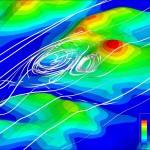
Natural Power’s assessments of its new modeling software has shown that it runs 1.7 times faster than the previous installation.
Renewable energy consultancy, Natural Power, has been developing new models for more accurately predicting wind-farm performance. According to the company, the investment in new high-performance computing has enabled the business to produce results from its most advanced computational fluid dynamics (CFD) models at wind-farm scale within five to six days. This is a large improvement over the 60 days required before.
Claude Abiven, Senior Technical Manager at Natural Power, said: “The improved speed creates an obvious commercial advantage. No client wants to wait 60 days for modeling outcomes. More significantly, it means we can increase certainty in our calculations, which can be directly translated in to cost savings. When the bill for a wind farm runs in to hundreds of millions, that’s an important factor – and a potential game changer for the industry.”
Simple linear wind-flow prediction models can run off a laptop computer, but more computationally intensive models are required when farms are located in complex or forested terrain or in the presence of complex atmospheres (such as sea breezes).
In these circumstances, linear wind-flow models provide a much less accurate picture. To overcome the limitations of existing techniques, Natural Power worked in partnership with the Faculty of Engineering at the University of Porto (FE-UP) in Portugal and Renewable Energy Systems (RES) to develop a more advanced CFD.
While developing the model, Natural Power realized it wouldn’t be able to run effectively on its existing server and so has selected a SuperMicro supercomputer powered by Intel Xeon processor E5-2660 v3. Internal assessments have shown that this runs 1.7 times faster than the previous installation.
With greater computational power and more certain modeling, Natural Power has positioned itself to take advantage of renewed growth in demand for wind-powered energy generation.
“Wind power has enormous potential but there are multiple variables involved at each installation that will affect yield and, consequently, the financial viability of both new and existing sites,” explained Abiven.“Typically our customers need an accurate picture of the likely output of the wind farms they are planning to build or buy so they can determine projected profit and hence the loan criteria. The more accurate the calculation is, the more attractive the terms for financing become – and the more easily wind power can be integrated into the overall energy mix.”
In 2014, the wind power industry set a new record for annual installations. According to the Global Wind Energy Council (GWEC), worldwide generating capacity increased by 51,477 MW to reach 369,553 MW. GWEC also suggests that wind power could supply between eight and 12% of global electricity by 2020.
Behind this increase in wind-power installations is a complex series of calculations and analysis of potential performance. When planning new installations, investors, utilities, and turbine manufacturers all need an accurate picture of what the energy yield will be, whether it will deliver an attractive return on its financing, and whether it will affect local populations and wildlife.
Natural Power helps global wind-power clients create and analyze this picture. It currently manages 2% of the UK’s installed onshore wind capacity and is steering more than 50 wind farms through construction.
Natural Power
www.naturalpower.com
Filed Under: News, Software




